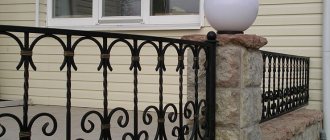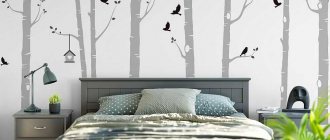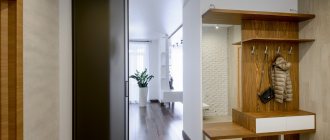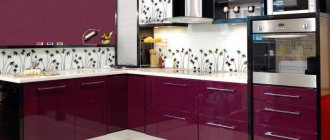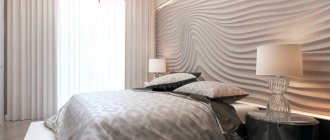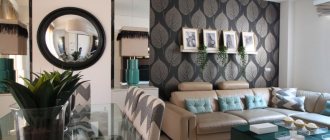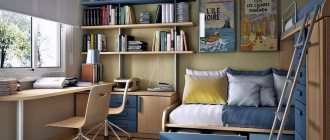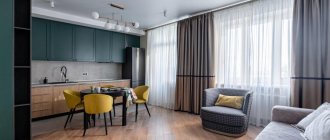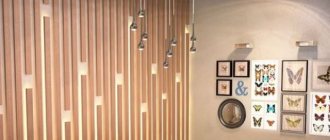SHARE ON SOCIAL NETWORKS
FacebookTwitterOkGoogle+PinterestVk
First of all, stair railings are designed to ensure safe movement. In addition to stairs, they are also necessary for other potentially dangerous structures: balconies, terraces, verandas. Most often, wood, metal, and durable glass are used for manufacturing. To make the staircase look harmonious, its constituent elements are made in the same style. At the same time, one should not forget to “adjust” the design to the surrounding interior.
The main task of stair railings is to ensure safe movement
Types of stairs: basic requirements for organizing the structure
The type of staircase in a private house or two-story apartment should be considered at the stage of construction or renovation. When arranging a space, you need to understand that the staircase is a massive structure that occupies a prominent place in the room. For this reason, it is important not only to take into account safety aspects, but also to select the optimal design, shape and material of manufacture so that the product becomes an extension of the surrounding interior. There are these types of stairs in the house:
The following types of stairs can be installed in the house: straight, spiral, combined and marching
- straight;
- rotary;
- screw;
- curvilinear;
- combined;
- curved;
- marching.
A separate group includes aerial stairs, which are steps mounted with one edge into the wall. This option looks laconic and will be an excellent addition to an interior in a high-tech style or other modern style. As for design issues, when choosing a design you should rely on the following basic recommendations:
- If the staircase is large and located at a large slope, small platforms should be arranged every 8-12 steps so that you can rest and catch your breath during the ascent.
- The optimal width of the step is considered to be 80 cm. This distance is enough for 2 people to safely pass each other on the stairs.
- For average height, a comfortable step height for climbing is considered to be 15-20 cm. The parameter should be selected based on the average height of the occupants of the room.
- The minimum depth of the step should not be less than 25-30 cm.
- When creating a landing, you need to take into account that it must be wider than the flight of stairs.
- You should not design a staircase with a slope of more than 45 degrees, because otherwise the product will not be considered safe. The optimal indicator is an angle of 25-35 degrees.
- The material for constructing stairs should not be flammable. Even if wood is used for manufacturing, it must be treated with special fire retardants.
A step width of about 80 cm is optimal
Expert advice! The angle of rise of the stairs and railings directly depends on the area allocated for the installation of the structure. If space is very limited, it is better to give preference to a spiral staircase. Numerous twists and turns will help smooth out a large slope.
What kind of forging: cold or hot hand forging?
Forged railings, like any similar products, are produced in two ways: hot and cold forging. Each technology has its own advantages and disadvantages.
Hot forging involves processing metal at high temperatures, at which the material is heated to a plastic state. This method has the following advantages :
- variety of forms;
- originality of design;
- elegance and subtlety of product execution;
- high artistry of finished structures.
Hot forging has some disadvantages :
- high cost of projects;
- low production speed;
- high labor costs;
- impossibility of mass production.
Cold forging is metal processing carried out at room temperature. Giving the workpieces the required shapes is carried out using machine stamping, as well as manual or automated bending using special equipment. The assembly of elements is carried out by welding, less often using screw connections.
Advantages of the technology:
- low price;
- high speed of project implementation;
- high accuracy of product size and configuration;
- low labor intensity and cost-effectiveness of the process;
- high performance;
- favorable working conditions for employees and home craftsmen.
Disadvantages of cold forging:
- simplicity of forms;
- lack of exclusivity;
- availability of special equipment, tools, stencils.
Depending on the financial capabilities and wishes of the client, safety and design requirements, the choice should be made on the optimal solution. Cold forged railings are suitable for municipal and government institutions, for modest premises: private and commercial. For rich and luxurious interiors of cottages, mansions and country houses, you should choose original wrought iron railings that emphasize the presentability of the design.
What are railings: the feasibility of installing them
Railings are an essential element of any staircase. In addition to the fact that the products increase the comfort of use of the entire structure, they provide additional safety and make the staircase more durable and stable. It is thanks to the fences that you can give the staircase an original and complete look.
It is a mistake to think that handrails are needed only by older people, children, or those who have problems with the musculoskeletal system: it is generally accepted that these categories of people have difficulty with stability and safe movement along the steps.
In addition to providing safety, railings also serve an aesthetic function.
Most designers argue that even healthy adults prefer to use stairs equipped with handrails and railings because they create a feeling of safety. In the event of a fall or other unforeseen situation, a person will grab onto the railings.
In addition to the fact that stairs with railings are more convenient to use, the elements also serve an aesthetic function, because they can be given an attractive appearance. Fences are made in any color, decorated with carvings or forged elements, depending on the interior, angular or rounded details are thought out.
A variety of materials will help give fences an individual appearance; it can be wood, plastic, metal or glass. The railings can be attached to the steps or mounted into the wall - everything will depend on your imagination, the features of the installation location and the chosen interior design.
The railing can be mounted into the wall or attached to the steps
What other elements does the stair railing consist of?
So, in addition to the railings, which provide convenient descents and ascents of the stairs, the fencing elements include:
- handrails;
- balusters.
Handrails are essentially the part of the railing that is located at the top of the fence. It is the handrails that a person holds on to when using the stairs. Interestingly, if you lean on the handrails during a long climb, you can remove up to 20% of the load from your legs. These fencing elements are fixed to balusters; they can be located on one or both sides.
Helpful advice! It is recommended to install handrails on both sides if the width of the staircase exceeds 125 cm. When the structure is installed along the wall, you can attach the handrails directly to the wall surface.
Handrails and balusters are the main elements that make up the railings
Balusters are support posts that are used to secure the fence to the surface of the step. In addition to performing a decorative function, balusters increase the load-bearing capacity of the staircase. Fillers are installed between them. According to their design, racks are divided into the following types:
- Classic. They are the most common option, consisting of vertically installed or inclined figured rods.
- Solid. If you look at the photo of balusters for stairs, you will notice that this option is considered the safest for homes where children live and there are pets. It will not be possible to crawl between adjacent elements, because they are installed close to each other.
- Crossbars. A simple design consisting of the intersection of vertical and horizontal slats.
- Patterned. Here everything will depend on the imagination of the performer, because it is appropriate to give the filling any artistic form. A fence made of balusters made using various monograms looks beautiful in a classic interior.
To create unique products of their kind, it is permissible to use a combined design of fencing. Sometimes the installation of balusters on the stairs is replaced with a bowstring, which is a horizontal fence fixed under the handrails parallel to the stairs. Some railings may also have a cap, the so-called curbstone, which is installed at the beginning and end of the span instead of balusters. The plug is a purely decorative part that does not carry any functional load.
The combined design of the railings will help make the fence unique and original.
This is interesting! On trading floors you can find ready-made prefabricated or one-piece versions of railings. If you decide to make custom-made products, you need to be prepared for waste, both monetary and time. But an exclusive staircase, made in a single copy, will always be the pride of the owners.
Peculiarities
When designing a building, special attention is always paid to the quality and attractiveness of the entrance area. The porch is considered the heart of the composition. It can be made into anything, from large oval ones to small original buildings. Despite this diversity, certain regulations clearly state that if the porch has two or more steps, it must have a fence. Thanks to modern technologies, railings can be made from various materials.
As practice shows, consumers give their preference to metal and wood. After them comes natural stone, concrete, glass and plastic.
Railings are not only a beautiful, but also a functional design. Her main “responsibilities” are:
- creating support for people when going up or down stairs. This is especially important for homes where elderly or young residents live;
Railings are important for elderly people and children
- guaranteeing safety. Having handrails can minimize the likelihood of injury in certain situations;
- improving the appearance of the house. If there is no railing on a porch with steps, it, and the entire house, loses its appeal. Railings add a finishing touch to the home.
Basic norms and standards: what should be the width and height of the railings on the stairs
Properly selected stair railings will ensure the safest possible movement along the steps, thereby reducing the risk of injury. Sometimes you can find a design option for stairs without railings. They look very unusual, but many note that using them is quite inconvenient. You should know that certain standards have been developed regulating the dimensions of elements. As for the height of the staircase railings, it is recommended to select the best option depending on the average height of the occupants of the home.
Most experts will recommend experimentation when designing handrails. To do this, you need to stand comfortably on a step and extend your arm forward, then measure the distance from your palm to the step. It is the resulting value that will be the optimal height of the handrail. Traditionally, the minimum height is 90 cm, the maximum handrail is raised by 110-115 cm.
The optimal height for stair railings is 90 cm
If small children live in the house, you should not attach an additional stationary handrail, because within a year the child will grow up. It is better to install a temporary element that will run parallel to the main one. Other fencing options:
- The width of the staircase handrail usually varies from 3 to 7 cm. It is important to choose a diameter so that the part fits comfortably in your hand.
- The distance between individual balusters can be any, because in this case everything depends on the artistic intention of the owners of the building. Typically the figure ranges from 50 to 70 cm.
Other standards that railings and fences in buildings must comply with
In accordance with GOST standards, as well as in accordance with the state SNiP, it is recommended to adhere to the following parameters:
- stair railing height – 90-100 cm;
- the distance between adjacent posts is 60 cm;
- mandatory presence of filling between balusters;
- the gap between the wall surface and the handrail is 7-10 cm;
- the distance over which the rounded end of the railing should protrude relative to the last step is 30 cm.
There are also separate standards for the load for which stair railings in a private home and public buildings must be designed. All data was obtained on the basis of tests carried out in accordance with SNiP 2.01.07-85. Thus, when creating structures, it is recommended to rely on the following load parameters:
Depending on the purpose of the institution, fencing must withstand a load in the range of 30-150 kg/m²
- social institutions: children's institutions, hospitals and sanatoriums - more than 80 kg per square meter of fence;
- office buildings – 30-80 kg/m²;
- residential buildings – 80-100 kg/m²;
- premises designed for sporting events, stadium stands - more than 150 kg/m².
Other mandatory safety requirements (according to SNiP):
- It is mandatory to install handrails if the staircase consists of more than three steps;
- there should be no sharp corners or protrusions on the fence;
- it is necessary that the balustrade completely frames all flights of stairs.
Separate recommendations are also made regarding railings and railings for stairs in children's institutions (in accordance with the standards of the 1.256-1 series):
- an additional handrail should be installed at a height of 50 cm from the floor;
- for greater convenience, it is recommended to use rotating brackets for the railings during installation, allowing you to change the angle of inclination;
- It is strictly forbidden to use glass filling between balusters;
- the clearance between the posts and balusters is no more than 10 cm;
- fence height – 1.2-1.8 m.
According to SNiP, it is necessary to install railings if the staircase consists of more than three steps
Helpful advice! If people who use wheelchairs live in the house, a ramp is installed instead of stairs, and railings must be installed on both sides.
Before you start designing stairs, you should familiarize yourself with the recommendations regarding the arrangement of structural parts of the railings, which are given by experts in this field:
- The number of balusters is determined by the number and dimensions of the handrails. If the base consists of flexible and heavy materials, then the number of supports should be such that sagging of the profile or excessive overload of the supports can be prevented.
- According to the standard, balusters are installed on each step, but if they are wide, it is possible to install several supports on one surface. When children live in the house, the distance between the balusters should be such that the baby cannot stick his head between them.
- If the flight width is more than 1 meter, the staircase is equipped with railings on both sides.
- Wooden railings for stairs are allowed to be installed only in private residential buildings.
- In office buildings, it is better to install a bowstring instead of balusters.
- When arranging the space of a shopping and entertainment complex, it is imperative to use at least three crossbars for railings.
Related article:
Wooden railings for stairs: when natural beauty brings comfort
Subtleties of creating railings. Design tips. Instructions for the manufacture of individual parts. Types of installation.
Design, distances, dimensions
Handrails for stairs are necessary for safer use, as they are an enclosing structure that prevents injuries. There are models of stairs that do not require any railings. They may look interesting, but using such stairs is scary. Typically, stair railings consist of several elements:
- Support pillars. They are a mandatory part of the structure, installed at the beginning and end of each span and between them in increments of 50-60 cm. Support pillars are also placed at the corners of the turntable. They must be strong, securely fastened as they bear the main load.
Structural elements of stair railings
- Handrail. The structure that connects the tops of the support posts serves to provide support during lifting and to create the building envelope itself. Handrails can also be attached from the second side - to the wall. Such double handrails are made when the width of the steps is more than 120 cm. The minimum height of the handrail is 90 cm, the maximum is about 100-110 cm. The second option is for tall inhabitants. For ease of use, if there are small children or short people in the family, you can install a second handrail below, which will be comfortable for them to hold on to.
- Filling. This is an optional element, but most often, in one form or another, it is present. The distance between the support posts (pillars) is 50-60 cm. If there are no children in the house, this space can be left empty. But usually, in the gaps, balusters (vertical posts), longitudinal elements connecting pillars, patterned or forged filling, pieces of glass, plastic, etc. are installed.
Such a simple design, and it has a great many options. And it is the railings for stairs that give them a special charm and uniqueness and set the style.
Fencing for stairs: types of designs, materials for manufacturing
As the previous information shows, there are a large number of ways to arrange railings for decorating stairs. The choice of a specific option will depend on the location and structural features of the flight of stairs. In general, the following types of fencing for stairs in a house are distinguished:
Stair railings can be installed both inside and outside the house
- Interior. As the name implies, such structures are located indoors. In most cases, interior stairs are made of glass or wood, and the shade is selected depending on the surrounding interior.
- Exterior. This includes outdoor stair railings framing a veranda, porch or balcony. It is necessary that the material can withstand various weather conditions well. Outside residential premises, metal and concrete are used for fencing.
The most popular materials used for fencing include:
- Metal. Basically, aluminum is used for the production of railings, which has an impeccable shine, or forged steel, which has unique decorative properties. Forged products are often made to order.
- Tree. The most popular material for creating stair railings in a private home, because wood is warm to the touch and fits into most interiors.
- Polymers. The main material here is plastic, mounted using special fasteners. The main advantage of such products is their low cost.
- Glass. Glass railings for stairs are mainly used to organize space in shopping or office centers. Only tempered glass is suitable for creating structures.
- Concrete. It is found mainly when decorating the entrance to a building or on main staircases. In this case, you can purchase ready-made structures in production or cast them yourself directly during construction. For work you will only need special forms.
The most popular materials for making railings are metal, wood, glass and concrete
Fences made by combining materials stand out. The most common option is a combination of forged or aluminum balusters with wooden elements.
As for the shape of the railing, in this case everything will depend not only on the installation location of the structure, but also on the material used to create the fence:
- Classic designs are made from wood. Most often, balusters are straight, massive columns with rounded edges, often decorated with carvings.
- Metal stair railings are usually not so massive, but the products are richly decorated with decorative elements.
- Glass is not a very malleable material (unlike wood and metal), so this type of fencing will have a strict and laconic design.
Features of using wooden stair railings
Despite the fact that the building materials market does not stand still and is constantly replenished with new products, wood does not lose its relevance, so such railings continue to be actively purchased. This is due to the fact that this material is of natural origin and is not capable of harming the health of others.
The main advantage of wooden fencing is its attractive appearance.
The main advantages of wooden fencing:
- attractive appearance;
- pleasant structure and texture;
- ability to withstand mechanical damage;
- resistance to negative environmental influences.
It should be noted that all these benefits can be increased if wooden structures are periodically treated with special solutions. Pre-treated wood can be used not only indoors, but also outdoors.
It’s quite easy to choose the appropriate option for the job, because trading platforms offer products made from various types of wood, differing in design, color and quality. But fences made from different types of wood will differ in cost. Pine products are considered the cheapest. Oak structures are considered elite and durable, which is why they are characterized by a high price.
Wooden balusters are used to decorate interior staircases in houses more often than others. They are attached both to steps and to wooden handrails. Depending on the type of staircase, balusters differ in type and size. The size of the standard section is 45x45 mm: the wider the staircase, the greater this figure. Sometimes there are balusters whose cross-section is larger than 50x50 or 60x60 mm.
The size of the standard section of a wooden baluster is 45x45 mm
A significant disadvantage of wooden stair railings is that the material, due to its natural origin, is subject to swelling and shrinking, especially if the ambient air conditions are constantly changing. This can reduce the strength of fences, and exterior stairs can become deformed and change color.
Why are stainless steel and aluminum stair railings popular?
Fences for stairs made of stainless steel or aluminum are widely used in the organization of exteriors and interiors. Nickel-plated or brass options, which were very popular at the end of the last century, are installed a little less frequently. It was then that fencing made of brass and nickel was used to furnish office and shopping centers.
This is interesting! Metal railings have long been widely used due to their high consumer characteristics and versatility, which allows such structures to be used with equal success both indoors and outdoors.
Among the main advantages of metal railings for stairs are:
Stainless steel fencing has become very popular lately.
- Long service life. Handrails and railings made of metal, with proper care, can last up to 50 years.
- Attractive appearance. Metallic shine can decorate any modern and even classic interior.
- Easy care. The products do not require constant maintenance, which consists of tinting or varnishing elements. There is no need to apply antifungal or fireproofing solutions, as is the case with wood. The only thing that needs to be done is to wipe the fences with a damp cloth from time to time.
- Resistance to destruction. Steel and aluminum, like other metals, are resistant to the appearance and development of rust; it is this fact that allows such structures to be installed everywhere.
- Price. Stainless steel stair railings will cost much less than glass or forged products, but they are more expensive than wooden ones.
In addition to a large number of advantages, fencing also has some disadvantages. Thus, many users note that with active use of the structure, the ability of the material to withstand mechanical damage decreases. The surface is covered with small scratches and chips, which can be felt to the touch, and the joints become loose.
The advantages of stainless steel stair railings are long service life and attractive appearance
Advantages and disadvantages of wrought iron handrails for stairs
Wrought iron railings for stairs are considered an expensive but high-quality option. At the same time, the finished structures are distinguished by exceptional beauty and sophistication. Several forging technologies are used to make railings:
- Cold. The result of the work is simple forms - twisted rods. As a rule, such railing options are found on verandas or other outdoor structures.
- Hot. It requires significant labor and time, but the result is railings of unusual and ornate shapes. It is hot forging that allows you to create the most complex designs, but you need to be prepared for large financial costs.
The main advantages of forged stair railings:
- Resistance to aggressive environmental influences. Fences withstand the effects of precipitation, temperature fluctuations and humidity well without losing their appearance. In addition, they are not subject to mechanical damage.
- Long lifespan. Forged products in most cases, even after 100 years, will look beautiful and attractive.
- Unique design. Forging is used mainly to fulfill individual orders. Thus, it is possible to decorate the staircase with exclusive railings.
The only disadvantage of forged railings is the high cost, because the entire manufacturing process is an exclusive handicraft.
Wrought iron railings for stairs are made by cold or hot forging
Features of plastic and glass railings for stairs
Glass stair railings are an excellent solution for modern interiors in high-tech, minimalism, fusion and other styles. Due to the fact that only strengthened (tempered) glass is suitable for creating railings, the products are endowed with a large number of advantages:
- Ease and high speed of installation. You can install fencing yourself without using any complicated tools. By and large, the entire installation process will take no more than a few hours.
- Large assortment. There are a variety of material options available on trading platforms, which are characterized by additional advantages, such as sound insulation and frost resistance. More expensive glass railings for stairs are explosion and heat resistant.
- Durability. Glass structures can be used for as long as metal ones - about 50 years.
The advantages include the possibility of quick dismantling. If any of the sections becomes deformed or loses its integrity, there is no need to disassemble the entire structure, because all sections are located autonomously.
The best solution for interiors in high-tech, minimalism, and fusion styles are glass railings for stairs
Among the disadvantages of glass railings for stairs for a country house, it is worth noting the need for constant maintenance. If the glass is not regularly wiped, then there will be stains, fingerprints and other contaminants on the surface, spoiling the appearance of the entire structure. Another disadvantage is the high cost of finished products.
To produce composite railings, hard plastic is used, mounted on a special clamp. The main advantage of polymer fencing is its low cost, because cheap plastic is used to manufacture the products. It is important to understand that the advantages of plastic fencing do not end there. Other advantages include:
- easy maintenance, because the plastic is easy to remove stains and polish;
- no need for regular paint or varnish treatment.
At the same time, a significant disadvantage of plastic fencing is the low resistance of the material to mechanical stress and shock. If there is strong pressure or impact, the integrity of the structure will most likely be damaged.
The main disadvantage of glass railings is the need for constant maintenance.
Stone and concrete railings for terraces and other outdoor structures
Fences made of stone or concrete are mainly suitable for decorating outdoor structures: external flights of stairs, porches or verandas. The material is distinguished by its increased ability to withstand external influences, has significant weight, and is cold to the touch. It is for these reasons that concrete fences are not used inside houses.
Concrete can easily withstand negative atmospheric influences and looks monumental and presentable in appearance. With its help, you can highlight the exterior of the house and emphasize the high status of the owners. Depending on the specifics of production, there are the following types of stone balusters:
- Carved. As a rule, they are made by hand, which allows the elements to be given exquisite and varied shapes.
- Spot. A common version of fencing that has rounded shapes. A distinctive feature is the presence of point supports, the horizontal section of which has the shape of a circle.
- Hewn. Balusters are distinguished by smooth edges and angular shapes; the horizontal section of the posts resembles polygons.
For the design of street fencing, the best solution would be materials such as concrete and stone.
As for materials, other stones are also suitable for organizing railings:
- marble;
- Dagestan stone;
- granite.
All of these options are quite heavy, so a lighter and easier to process artificial stone is often used as a base. But the most durable fencing is obtained only by using granite, since this stone is one of the hardest rocks.
Important! Stone handrails and railings look attractive and expensive. But it should be taken into account that structures have a significant impact on flights of stairs, which must be taken into account when creating staircase designs.
It is recommended to combine stone fences with plank or metal stairs. Such a combination will play up the design and give the room a cozy and comfortable look.
Stone railings look very attractive and expensive
Materials
UE are made from:
- wood;
- stainless steel;
- metal;
- vinyl;
- natural or piece stone;
- concrete;
- glass;
- combinations of materials.
Let's look at each type in detail.
Wooden UP
The most common type of railing. They can be found especially often in private cottages. The wood has a good price and a nice texture. It is much easier to make beautiful UE from it. Masters of their craft create incredible balusters. Carved products are considered the most original. UP from WPC are very popular. But against the backdrop of all these advantages, wood has a significant drawback - susceptibility to moisture. To ensure that wooden UPs last longer when exposed to the street, they are treated with a fire-retardant and bioprotective composition, and a vapor-impermeable primer.
Wooden UP
Advantages
- attractive and original appearance;
- simple installation;
- good strength;
- environmental friendliness and naturalness;
- safe operation.
Flaws
- the tendency of some breeds to fester;
- mandatory need for additional processing;
- To achieve the required surface, professional processing of the material is required.
Primer for wood
Stainless steel UP
Stainless steel is a very reliable material. Its unique shine makes UE weightless. If you want original stainless steel railings, choose a matte surface rather than a glossy one. Today the market offers a huge range of stainless steel products. A significant disadvantage of stainless steel is its strong dependence on the ambient temperature: under the sun they become very hot, and in frost they become very cold. The problem can be solved by combining wooden railings and metal balusters.
UP made of stainless steel
Forged UP
Forged construction is a classic. They harmonize with any exterior. The forging process hardens the material well, so it is very durable. Such railings are suitable for concrete, brick, wood and stone porches. You can buy ready-made CP or, having created your own sketch, order the railings to a blacksmith. Of course, forged products are quite expensive.
Forged UP
Advantages
- long-term operation;
- strength;
- easy installation;
- nice appearance.
Flaws
- require special processing to increase operation;
- high price;
- hot in summer, cold in winter.
Vinyl UP
Such PVC railings, as a rule, come complete. They come with decorative details, posts and headbands. Vinyl construction is easy to install. To enhance rigidity, it is mounted on a metal frame. Vinyl does not burn, does not rot or rust.
The disadvantage of vinyl UP is the lack of originality.
Advantages
- durability;
- large selection of shapes and types;
- easy simple installation.
UP made of stone or concrete
To make such railings, they use the same material from which the porch is built: granite, sandstone or marble. The stones are very difficult to work with, but the results are worth it.
Stone UP
Concrete is a good alternative to stone. Modern technologies make it possible to make it very similar to expensive material. In addition, concrete UEs are much more reliable and last longer. The price and installation of such products are quite high.
Concrete UP
Glass UP
Glass is highly sought after due to its original appearance. The glass from which fences and railings are made is called triplex.
Advantages
- refined and laconic appearance;
- environmental friendliness;
- resistance to temperature changes;
- strength;
- safe operation.
UP made of glass
UP from combined materials
As a rule, when creating UE, metal and wood are combined. The appearance of the metal "components" is often similar to strings. Sometimes this “blow” is supplemented with glass.
Why are the upper supporting elements of the railing needed: fences made in various versions
In order for the railings to be comfortable and safe to use, they must be equipped with handrails, which are made in different forms and using different materials.
As for the shape, the handrails are:
- round and oval;
- rectangular and square;
- corner;
- rounded.
The material is selected depending on the purpose, features of use and location of the staircase. If we talk about the porch, here you can most often find forged, chrome-plated, aluminum and other metal stair railings.
Handrails made from PVC can easily imitate any surface, but they are not as resistant to external influences. The main advantage is the high plasticity of the material, which allows you to give the elements any, even the most unusual, shape. To do this, you will need a hair dryer or other device that blows warm air. PVC handrails are also characterized by their low price.
Wrought iron railings with wooden handrails are the most popular railings for stairs
For many years, wood has been the most popular material for handrails due to the special comfort that wooden elements provide. Some people decorate wooden stair railings with their own hands, using artistic cutting, methods of aging surfaces, and applying special solutions.
Handrails are also classified according to the method of fastening. Some people mount the elements above the bowstring, but sometimes the handrails perform a load-bearing function. Handrails are attached to balusters in various ways: using anchors or self-tapping screws, or by welding. For installation on a wall or along a staircase, special cast brackets are used that allow you to grasp the bar from any side, including the end.
If you want to emphasize the individuality and unusualness of the interior, they resort to creating handrails of non-traditional shapes from scrap materials:
The material for handrails is selected depending on the purpose, location and features of use of the stairs
- Rough handrails made from untreated timber will fit perfectly into the interior of the chalet. This option will help place accents in the room and emphasize the unusualness of the interior.
- In a modern loft or minimalist style, railings made of branches in combination with PVC look appropriate.
- A nautical or rustic style is well emphasized by a rope or thick rope. In this case, this option can be performed at the dacha or in a private house.
Installation
Installation of railings in a private house is carried out according to the same principle, and the design of the spans can be changed from floor to floor.
First, the main pedestals are attached to the finished staircase, which will stand either only at the top and bottom, or evenly distributed along the high rise. They are also attached at each turning section.
To mark between the supporting tables, stretch a twine rope or fishing line, which allows you to correct the uneven position.
Next, install balusters or posts for the inserts. The sections are mounted inside pre-installed verticals.
Installation of balusters
Finish the work by securing the handrails. All grooves for inserted elements are pre-cleaned and degreased to ensure maximum adhesion.
When installing, use assembly glue or self-tapping screws, but with glue you get a more neat final look.
All that remains is to wash or thoroughly wipe the freshly assembled structure from dust, construction crumbs, remove debris and leave the adhesive to dry.
If a wooden staircase was installed, then you can think about how to make a handrail for a wooden staircase with your own hands and carry out the finishing treatment. Wooden railings for any stairs must be varnished.
The procedure for assembling a wooden fence is shown in more detail in the following video:
Voted over 362 times, average rating 4.8
Comments
Unfortunately, there are no comments or reviews yet, but you can leave your...
Add a comment Cancel reply
We recommend reading
Stairs How to properly install a plywood staircase and cover it Steps are the main element in the construction of a staircase ...
Stairs How to decorate a concrete staircase in a private house Concrete internal staircase is one of the most durable, ...
Stairs Making a staircase to the second floor from a corner of a channel: design features, advantages and installation nuances Country two-story houses are one of the most popular types ...
Stairs How to make a staircase on rails Among all types of stairs, the newest and most technically advanced in ...
Painting
Before painting, the surface of the structure must be cleaned of various contaminants. The cleaning procedure is performed with sandpaper, a brush with metal bristles, a grinding machine or sand (sandblasting).
Then the performer begins degreasing and applying primer . Priming is not always required, it all depends on the paint chosen.
The industry offers special paints (hammer and powder) for forged products. These coatings guarantee high protection from mechanical influences, moisture, ultraviolet radiation, and provide a beautiful appearance. But structures located indoors are not exposed to such a wide range of harmful factors as outdoor railings. Therefore, to process home railings, you can choose water-dispersed or emulsion paints , which are used to process a wide variety of materials. This solution will allow the client to save money.
Particular attention should be paid to the choice of paint color. The shade should organically combine with the interior. You can find out more about painting here.
Light and white
White and light railings are suitable for spacious rooms decorated in warm colors. Wooden handrails will be a great addition. Such an interior envelops you with its coziness, convenience and comfort.
Photo “Reiri”
As for design, light or white wrought iron railings will be the optimal solution for a classic interior style.
Patinated
Enterprises offer several colors of patina for forged railings, the most popular: gold, silver, copper, bronze. Patinated designs are perfect for beige-brown colors and warm interior colors.
Rooms made in modern styles: minimalism, hi-tech, steampunk, etc. should not be decorated with patinated railings. There are no other exceptions.
Classics of the genre - black
Wrought iron railings, made in black, go well with a variety of shades and styles. That is why this color is most popular among designers and clients.
Private house and combinations with forging
Forged products are highly functional, i.e. harmoniously combine with many construction and finishing materials.
However, it is worth noting particularly excellent combinations .
The classic option is a combination of wrought iron railings and brickwork . The advantages of such a solution: wealth, luxury, presentability.
The walls of the building can be made of natural or artificial stone . Its combination with forged structures inspires a feeling of reliability, solidity, and solidity.
Photo by “TechInKov”
A fairly popular combination is forged products and wood . However, it is worth noting that you should not oversaturate the interior with natural wood. Otherwise, the forged railings will look pretentious.
A private house can be built from concrete slabs . On the inside, concrete blocks most often require additional coating. Since untreated concrete creates a feeling of coldness, lack of coziness and comfort.
To cover concrete walls, decorative plaster - a composition used to cover walls and ceilings. This coating has the following advantages: uniqueness, functionality, ease of application, safety, environmental friendliness, etc. Wrought iron railings will be an excellent decorative addition for an interior in which the surfaces are treated with this type of plaster.
Photo “Fine forging workshop”
Matte or glossy paint for walls and ceilings creates a fairly standard interior design. You can complement your surroundings or add some zest to it with the help of wrought iron railings.
